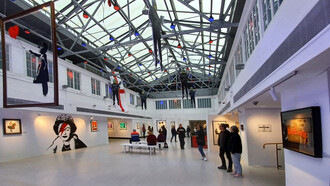Emotional, breathtaking, magnificent. These are my feelings about the project The Home of My Eyes curated by Thomas Kellein at Museo Correr in Venice as a collateral event of the 57th International Exhibition La Biennale di Venezia. Shirin Neshat, one of the leading international artists shows 26 portraits from The Home of My Eyes series together with her new video Roja.
The installation is really particular: at the Sala delle Quattro Porte on the third floor, in presence of a Gothic Madonna, a kind of ancestral mother, we can find black and white photographs inscribed with Farsi calligraphy as in other famous series like Women of Allah (1993-1997) and The Book of Kings (2012). “The Home of My Eyes combines 55 portraits of men and women from different generations, to create a tapestry of human faces which pays tribute to the rich cultural history of Azerbaijan and its diversity”, said Shirin Neshat. Commissioned by YARAT for the opening of YARAT’s newly built contemporary art center The Home of My Eyes portrays people from Azerbaijan (separated from Iran in the first part of 19th century) different for ethnicity, religion, age, culture, gender but similar in their clothes and poses against a dark background and also in their hand gestures remembering the Christian prayer gestures. “On my first and consequent trips to Azerbaijan in 2014 I was struck by how much it resembled my own childhood country, Iran; and how our shared history is still evident in the faces of people, as well as in our traditional architecture, music, literature and most ceremonial rituals. My experience with Azerbaijan therefore become somewhat distinct from any of my recent commissions, which had mainly taken me to the Middle East in particular to Egypt and to Qatar. Here in Baku I felt strangely at home, and connected to my past,” Shirin Neshat.
So she worked not only to photograph people but to capture human emotions, because, we know, she has really the power to see our souls, our emotions and feelings. She sees what is unseen and with her artworks she gives us the opportunity to see something from her point of view stimulating us to go over our daily certainty. “These are not only portraits but visual narratives of a culture.” In this way this series explores also the subjects’ individual voices: during the production Shirin Neshat spoke with them about their cultural identity and idea of home. So the texts inscribed across the portraits were composed by Shirin Neshat starting from the tales of the people she met and photographed and the poems by Nizami Ganjavi, a 12th century Iranian poet who lived in what is present-day Azerbaijan.
The whole project is focused on homeland. In the case of The Home of My Eyes the artist reflects about different experiences of homeland through the tales of the people photographed, instead in the video Roja, she reflects on some of her own personal nightmares, on her own experience of living in the foreign culture of the United States. Roja (2016) is part of a trilogy of video installations titled Dreamers (the other two videos of this trilogy are Sarah (2016) and Illusions & Mirrors (2013) starring Natalie Portman and premiered on the occasion of Biennale de Montreal in 2014) which explore the world of women’s dreams. Each of the three video installations revolves around a single female character whose narratives remain on the border of dream and reality/consciousness and sub-consciousness. Roja, based on Neshat’s personal dreams and memories, traces an Iranian woman’s nostalgia for her homeland. Employing a surrealist lens and nonlinear narrative, Roja captures the desire for a reunion with “home”, with “mother”, with the “motherland” that seems welcoming at first but becomes terrifying and demonic in the end. For the artist her mother is her last connection to Iran. “I saw my mother coming as a little dot from a distance and I ran toward her and she run toward me and as we got closer I couldn’t even stop myself. I noticed that she is not really my mother but a monster.”
So these artworks have a strong personal component but they become an expression of a generalized existential condition of identity, security, membership in a globalized world where mobility (in the broad sense) and uncertainty are some of the central components. A really interesting and emotional project in line with The Written Art Foundation supporting “artists whose work allows cultures and values different from ours to inspire and to educate us, thus promoting a peaceful exchange and the idea of world citizenship.” A new world starts from Art.















